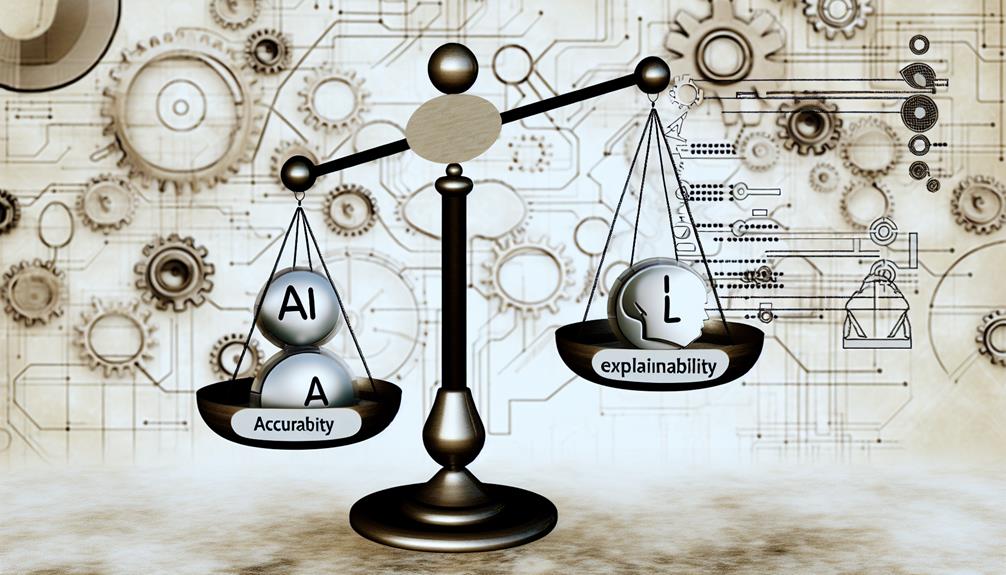When selecting machine learning models, several key considerations should be taken into account. First, define the problem type and scope to determine whether classification, regression, or other techniques are needed. Guarantee the chosen model can handle the data efficiently and consider its performance metrics, such as accuracy, precision, recall, and AUC-ROC. Next, evaluate model complexity and balance it with available resources and transparency. Additionally, explore various model options like logistic regression, decision trees, and neural networks to choose the best fit for the problem and dataset. Finally, strike a balance between model accuracy and explainability.
Key Takeaways
- Define problem scope and type to select suitable classification or regression models.
- Analyze data and assess available computational resources to ensure a model can handle it efficiently.
- Evaluate model performance using metrics like accuracy, precision, recall, F1 score, and AUC-ROC relevant to the problem.
- Balance model complexity against available resources and weigh it against overfitting and generalization.
- Choose models based on specific task and dataset characteristics, considering strengths and limitations of algorithms.
Understand Problem Requirements
Understanding the problem requirements is an essential first step in machine learning model selection, as it involves defining the type and scope of the prediction needed to formulate an effective strategy.
To select the best machine learning model for a specific problem, it is crucial to define the problem correctly. This involves determining whether the task requires a classification model to predict categorical variables or a regression model to estimate continuous values.
Analysis of the data size, complexity, and feature space is also important to ensure that the chosen model can handle the data efficiently.
Moreover, considering the available computational resources and time constraints will help determine which model can deliver the required results within the given timeframe.
Evaluate Model Performance Metrics
Failure to correctly evaluate model performance metrics can result in poor model selection, further highlighting the significance of accurate metrics formulation. Model evaluation is a crucial component in the selection of machine learning models. The choice of performance metrics largely depends on the nature of the problem, including accuracy, precision, recall, F1 score, and AUC-ROC.
When dealing with binary classification models, precision and recall are essential for accurate evaluation. Precision measures the fraction of true positive predictions among all positive predictions, while recall measures the proportion of actual positive instances that are correctly predicted. The F1 score provides a balanced measure between the two.
Additionally, techniques like cross-validation and ensemble methods can enhance model evaluation. Cross-validation guarantees that the performance metrics are robust and unbiased, as it assesses the model's generalizability across multiple datasets. Ensemble methods, such as boosting or bagging, combine multiple models to improve overall performance and provide more detailed insights.
Ultimately, balancing accuracy and interpretability is crucial when evaluating model performance metrics. This balanced approach helps in selecting the most suitable model based on both its predictive power and understandability.
Effective model evaluation is vital for building and deploying high-quality machine learning models.
Consider Complexity and Resources

Evaluating the complexity of a machine learning model must involve a thorough assessment of the available resources, guaranteeing that the selected algorithm can effectively handle the scale of the data and computational demands. This includes considering the trade-off between model complexity and interpretability, as more intricate models often offer better performance at the cost of being harder to understand. Scalability is a crucial aspect, as the model should be able to handle larger datasets or increased computational demands without compromising performance.
Model complexity also directly influences the training time and required resources. While selecting more intricate models may provide superior prediction power, simpler models can avoid overfitting and improve generalization on new data. It is therefore essential to weigh the complexity of models against the available resources to guarantee they align with project timelines and constraints.
Explore Different Model Options
Selecting the best machine learning model involves a thorough exploration of different model options, including logistic regression, decision trees, random forests, support vector machines, and neural networks.
Each of these machine learning algorithms is suited for specific tasks and offers unique strengths and limitations. For instance, logistic regression excels in handling binary classification and providing clear results, while decision trees are well-suited for non-linear boundaries but may lead to overfitting.
Random forests, on the other hand, balance trees to avoid overfitting and make them robust but also more computationally expensive. Support vector machines are ideal for datasets requiring clear margins between classes and can handle high-dimensional data well.
Neural networks are flexible and perform exceptionally well in complex tasks like image recognition but can be challenging to interpret. It is vital to understand these differences, as they directly impact the best model choice for a specific dataset or challenge.
During the model selection process, consider supervised and unsupervised learning approaches and the requirements of your particular problem to make an informed decision.
Balance Accuracy and Explainability

Accurate model performance is only half the battle; it is equally important to make sure that the selected model is explainable, fostering transparency and trust in its predictions. Balancing accuracy and explainability is essential in machine learning model selection.
While high accuracy is necessary for model performance, explainability guarantees that the model's decisions are understandable and reliable. Complex models like deep neural networks often provide high accuracy but may lack explainability, making it difficult to interpret their decisions. On the other hand, simpler models like decision trees offer a good balance between accuracy and explainability, making them suitable for many applications.
Understanding the trade-off between accuracy and explainability aids in selecting the most appropriate model for the specific use case. For instance, in applications where accuracy is paramount, such as medical diagnosis, complex models might be preferred. However, in situations requiring transparency and accountability, such as financial decision-making, models with high explainability are more suitable.
Frequently Asked Questions
How to Select the Best Machine Learning Model?
To select the best machine learning model, consider performance evaluation through cross-validation, balance feature selection and model complexity, optimize hyperparameters, and prevent overfitting. Guarantee interpretability, employ ensemble methods, and focus on data preprocessing and model deployment considerations.
What Are the Factors to Choose a ML Model?
Choosing the right ML model involves evaluating feature selection, performance metrics, and model complexity. It's essential to balance interpretability and accuracy while preventing overfitting, tuning hyperparameters, and preprocessing data. Scalability and domain knowledge integration also matter.
How Do You Choose a Data Model in Machine Learning?
To choose a data model in machine learning, evaluate model performance using techniques like cross-validation and bias-variance tradeoff analysis, and consider factors such as feature selection, hyperparameter tuning, overfitting prevention, ensemble methods, model interpretability, data preprocessing, and model scalability for best selection.
How to Choose Which Model Is Best?
To choose the best model, consider the problem type. Then, evaluate models based on performance metrics, feature selection, hyperparameter tuning, and cross-validation.









